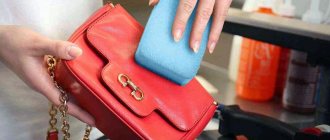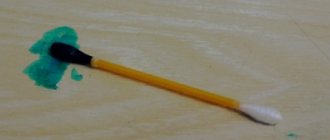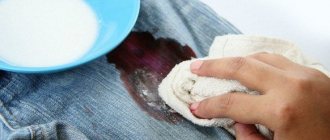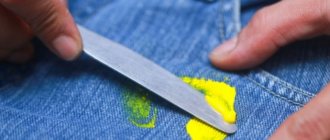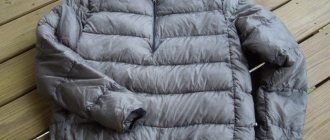Blood is considered one of the most difficult and problematic types of contaminants on clothing and other fabric surfaces. You can’t just throw something like this into the machine and start the wash as usual. It is imperative to pre-soak and clean this area, and only after that can you proceed with the main wash. The fresher the marks, the easier and faster it is to remove them. In this article we will tell you how to wash blood from clothes and furniture.
No time to read? We talked about the basic laundry detergents in the video.
Is it possible to remove blood stains using traditional methods?
The first impulse when many people see blood on their clothes is to try to wash everything in hot water. This is the most common mistake! Fresh stains are removed with cold, and old stains with heat. But not very high temperatures!
To prevent the stain from becoming old and difficult to deal with, do not delay the cleaning process.
The second important rule: it is strictly forbidden to rub fresh bloody dirt. It seems to us that if you take a brush and rub the stain with it properly, it will disappear. Whatever the case! With these movements we only rub it into the deep layers of tissue. The stain needs to be blotted, removing excess liquid, and then proceed according to the recommendations for washing this type of fabric.
It is important to take into account the type of material: gasoline and solvent are not suitable for synthetics, you need to be more careful with stain removers. Therefore, first we will try to derive the trace using traditional methods.
Removing a fresh stain
If it is clothes, then first we go to the bathroom and rinse the problem area under running water. Next, pour cold water into a basin and leave the clothes there for 30 minutes, after which we change the liquid. Salted cold water has worked well for soaking.
Now apply hydrogen peroxide to the dirty area with a cotton swab and press it. The stain will begin to lighten right before your eyes.
After treatment with peroxide, the stains are washed with 72% laundry soap. Now it’s better to put the item in the washing machine. If it has a stain removal mode, that would be ideal. But, unfortunately, if the fabric is not white, but colored, then the entire design may fade along with the disappearance of the blood trail.
If the fabric is thin, like chiffon or silk, then the problematic area should be lubricated on both sides with starchy water and left to dry. The starch is then shaken off and the clothes are washed.
If the stain is old
Don't despair if the dirt is old. First, the affected area is wetted in cold water, and then ammonia is used. A solution of 1 teaspoon of alcohol per glass of water is suitable. An hour later the item is washed.
You can soak soiled clothes for 4-5 hours in a salt solution at the rate of 2-3 teaspoons per 1 liter of cold water. Then do normal washing.
Important! You can't take too much salt. A strong concentration is more likely to help the protein in the blood clot, and such contamination is almost impossible to remove without leaving a trace.
There are other proven means.
Soda
Baking soda works well for this problem. You need to take 1 liter of cold water and stir 2-3 tablespoons of soda in it.
Only the dirty area is injected into the solution and the item is left there for 12 hours.
After this, ideally, it would be good to use a stain remover, if possible, and then wash the item.
Glycerol
Glycerin is heated in a small amount in a water bath (one bubble is enough). The warm solution should be applied to a cotton pad and used to wipe the blood.
Moreover, the back side of the product is processed first, and then the front side of the product.
Remove the stain with glycerin until it disappears completely.
Starch
Starch removes old blood stains. The product works especially effectively on delicate fabrics. Using this method, it is necessary to treat the dirt on both sides of the item with starch pulp.
How to update color and remove scuffs
Suede leather is very sensitive to influences, so it can deteriorate from improper care, prolonged exposure to the sun, or exposure to reagents. The following will help restore the color of the material:
- Special spray paint. To paint a faded area, spray the paint onto the suede from a distance of 15–20 cm. Leave for 5 minutes and repeat the procedure 2–3 times. If you paint shoes, put them on so that all the creases are straightened out.
- Coffee grounds. This is a natural dye that will help restore the color of black things. Brew coffee and apply cooled grounds to the damaged areas. Let it dry and brush it off with a brush.
- Milk. Pour 1/2 cup skim milk, add 1 tsp. soda and mix thoroughly, then treat the discolored areas. This method will not only refresh the color but also help get rid of shine.
Fighting blood stains with industrial products
Various manufacturers have long rushed to the aid of those wishing to remove burgundy-red stains from clothes, furniture or carpets. Today the market offers to cope with the problem with the help of liquid (gel), powder and solid formulations.
Soap and a special pencil are considered solid products. The labels indicate what type of surface the composition is suitable for.
Effective stain removers for cleanliness
There are several worthy products that have the function of a stain remover. Oxygen-containing bleaches are the best in this matter, but there are also a number of powder products. There is a powder used in laundries - “Biomig”. It is diluted in cold water and the item is soaked before washing.
Another stain remover is probably known to everyone: Vanish.
Vanish is good as a multifunctional product to guard cleanliness
Fairy detergent will also help remove a bloody stain, if it is fresh; moreover, it is suitable for all types of fabric, both furniture upholstery and carpets.
"Eared nanny" as a stain remover is safe for children's things, but is very effective against blood stains
Among solid products, Antipyatin and Stork soaps are effective. The smells from them are specific, but the compositions work perfectly.
In what order do we act?
Before you literally plunge into the washing process, you should remember what chemicals do to our skin and put on rubber gloves.
The gloves are ready, the stain is in place, the stain remover is nearby. If this is your first time using the product, read the instructions on the label.
Advice! It is better not to risk the material and slightly reduce the concentration of the composition by diluting it with water.
By reducing the concentration, we will protect the tissue. The fact is that the product is applied to a limited area, and due to excessive attention to chemicals and subsequent washing, the thing may not look its best. A diluted product will not act so aggressively on the material, but it will still perform its function.
If you are tormented by doubts, it is worth applying the stain remover to some inconspicuous area of the material and slightly observing the reaction of the fabric. This advice is especially important for delicate fabrics.
If there is no doubt, then draw water with a temperature of 25-30ºС and carefully rinse the contaminated area. You need to move your hands in the direction from the edges to the center
We remember that you can’t rub anything: this applies to both fresh and dried stains. If the water becomes dirty, first remove the item and then drain the water. We repeat the process and this time leave the product to soak.
After half an hour, take a cotton pad or a new sponge for washing dishes. Apply bleach to the disc and carefully apply it to the dirt. There is no need to wash off the product immediately; it should work.
Important! Bleach is only good for white things. If you don’t have an industrial stain remover suitable for your type of fabric on hand, use traditional methods. This will be many times better than waiting for the blood to dry.
How to remove ink from suede
- Blot fresh ink as quickly as possible with clean, dry paper towels.
- Remaining ink can be removed from suede by gently wiping the stains with rubbing alcohol. Be careful, as alcohol can affect the dyes in the suede itself. The coloring on suede boots may fade or fade.
- If the ink stain cannot be completely removed, lightly scrub the stained area of suede with very fine-grit sandpaper. Be extremely careful - the result of your actions will be very difficult to correct. If you overdo it, you can rub the suede down to the ground and then a bald spot will appear on your shoes instead of an ink stain.
Elimination of unevenness of suede pile
- If you notice that the fibers on your suede boots are uneven (some fibers are longer than others), you can shave the suede with a regular safety razor.
- Dry your suede shoes and brush the lint in one direction. Lightly run the razor over the suede in the direction of the grain.
- If this is not effective, use a brush to lift the nap and shave against it. Be extremely careful! Too much force can shave off the bald patches on your shoes.
If none of the above tips helped and the stain remains on the surface of your suede shoes, buy a special suede shampoo at a household chemical store. Follow the instructions on the shampoo for best results. Suede conditioner will help restore faded colors.
How to care for suede boots
- After each wear, use a special brush to remove dirt from suede boots and store them in a dry place.
- You can stuff suede shoes with crumpled up old newspapers - the paper will absorb excess moisture and allow the shoes to maintain their original shape.
- Protective spray for suede forms a water-repellent film on shoes, which prevents them from getting wet and preventing dirty stains from penetrating deep into the suede fibers. The spray is best used when the shoes are new or after cleaning (after the shoes are completely dry).
Washing things with blood stains in the washing machine
Trying to completely wash a bloody stain in a washing machine without pre-treating it as described above would be a desperate step.
It’s also good if your machine has a stain removal mode.
If the desired mode is not available, you will have to select it manually. We immediately exclude even warm water: put only cold water. To the bare minimum.
In addition to the detergent itself, add a couple of tablespoons of table salt or a teaspoon of ammonia to the hole for the powder. If there is a stain remover suitable for the fabric, then use it instead of salt and ammonia.
How to remove blood stains in specific cases
We have done a general overview of removing bloody marks on fabric, it’s time to consider other options, because life is full of surprises, but we will be ready for them!
Denim items
You can use all the recommendations described above, but since denim is a thick fabric, you need to add a few things.
You should first soak the jeans for half an hour in cold water with the addition of liquid dishwashing detergent.
Then a microfiber cloth or sponge is used. Apply the cleanser with it and leave it on the stain for 15-25 minutes. Remove traces of blood with the same napkin, moistening it in water and applying it to the stain. Cleaning products for jeans include a mixture of baking soda, salt and starch, peroxide, and if the fabric is light, soda, heated glycerin and ammonia.
Ammonia is applied with a spray bottle and cleaning begins 5-10 minutes after application.
The process will probably have to be repeated many times.
After all the manipulations, the jeans are thoroughly rinsed in cold water and sent to the washing machine.
White fabric
White fabrics are more capricious than colored ones. A trail of blood may remain a rusty reminder forever. Who would like to sleep on such bedding or wear clothes with such “decoration”? Soda will help in the fight for whiteness. Take 25-30 g of baking soda and 2 glasses of cold water.
Soak the dirty area in the solution for half an hour
After soaking, use laundry soap or antipyatin. We treat the stain with it and put the item in the washing machine.
When working with white fabrics, it is recommended to use oxygen-containing bleaches.
Sofa upholstery
To remove blood stains from sofa upholstery, two points are taken into account: the type of upholstery and the type of stain remover.
Effective in the “anti-blood” business Antipyatnin, Dr. Beckmann, Amway SA8 SOLUTIONS™ (spray), Unimax Ultra
But besides these means, there are several more options to return the sofa to its former appearance. Let's consider the available methods.
When cleaning upholstery, any product is first applied to a damp sponge or cloth, and only then directed to the dirty surface. All cleaning movements are carried out only in the direction of the fibers of the material, and the stain is treated from the edge to the center.
If the upholstery is made of fabric, then 72% laundry soap will do, but you can remove dirt with regular aspirin. The tablet is dissolved in a glass of lukewarm water and the stain is treated.
If there is a baking powder in the house, which in itself perfectly breaks down protein compounds, then it is also used. It is enough to dilute 1 tablespoon of baking powder in 2 tablespoons of water. This paste should be applied to the stain for an hour, and then removed with a cloth and cold water.
Ammonia and borax are excellent at removing blood from fabric upholstery. You need to pour a glass of water and 1 teaspoon of ammonia into one basin, and take a teaspoon of borax into a glass of water in another.
The treatment is done one by one, first with ammonia, then with borax solution
If the upholstery is made of artificial leather, then the treatment is done with whipped foam from a solution of a glass of cold water, ammonia and dishwashing detergent. Clean the stain with an old toothbrush.
Leather upholstery will be cleaned of old blood stains again if you take 1 part lemon juice and the same amount of cream of tartar. Everything is mixed into a paste and applied to the dirt.
Patience, and after 10 minutes everything is washed off with a damp sponge
Suede furniture is cleaned with water and ammonia.
Mattress cover
A mattress cover won't become any more attractive when it ends up covered in stains from trying to remove blood stains. In the fight for the clean appearance of this product, all means are good. These are both traditional methods and stain removers.
All cleaning principles remain the same: cold water, applying the composition to a sponge, treating the stain towards the center from the edges, rinsing off the product with a damp sponge
There is no point in using every conceivable means to achieve your goal. You should not mindlessly mix chemicals. The reaction of substances on fabrics will be unpredictable and may lead to the need to purchase a new mattress.
Dry cleaning can always come to the rescue, where stains will be dealt with quickly and efficiently, if for some reason this was not possible at home
If our recommendations were useful, we will be glad to hear about it! In the meantime, watch video tips on the topic.
Fabric Features
Suede is popular among fashionistas. Previously, only boots and sheepskin coats were made from it, but in modern boutiques you can find more delicate items: a dress, a jacket, a bag, gloves. The appearance of the products is chic, the material adds style. But special care is required for suede clothing to ensure it remains chic for a long time. The material has a fleecy surface, can be dyed and looks more natural compared to leather. Two types of suede are popular in textile production: natural and artificial. The main rule for fabric is minimal exposure to moisture. Therefore, the products should only be used in appropriate weather.


